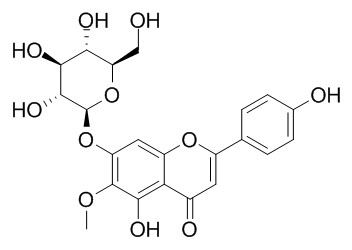Homoplantaginin
Homoplantaginin shows anti-inflammatory and antioxidant properties, it also has a protective and therapeutic effect on hepatocyte injury and shows potent inhibitory activities against influenza. Homoplantaginin may be used for the prevention and treatment of endothelial dysfunction associated with insulin resistance, it ameliorates endothelial insulin resistance by inhibiting inflammation and modulating cell signalling via the IKKβ/IRS-1/pAkt/peNOS pathway.
Inquire / Order:
manager@chemfaces.com
Technical Inquiries:
service@chemfaces.com
Tel:
+86-27-84237783
Fax:
+86-27-84254680
Address:
1 Building, No. 83, CheCheng Rd., Wuhan Economic and Technological Development Zone, Wuhan, Hubei 430056, PRC
Providing storage is as stated on the product vial and the vial is kept tightly sealed, the product can be stored for up to
24 months(2-8C).
Wherever possible, you should prepare and use solutions on the same day. However, if you need to make up stock solutions in advance, we recommend that you store the solution as aliquots in tightly sealed vials at -20C. Generally, these will be useable for up to two weeks. Before use, and prior to opening the vial we recommend that you allow your product to equilibrate to room temperature for at least 1 hour.
Need more advice on solubility, usage and handling? Please email to: service@chemfaces.com
The packaging of the product may have turned upside down during transportation, resulting in the natural compounds adhering to the neck or cap of the vial. take the vial out of its packaging and gently shake to let the compounds fall to the bottom of the vial. for liquid products, centrifuge at 200-500 RPM to gather the liquid at the bottom of the vial. try to avoid loss or contamination during handling.
PLoS One.2020, 15(2):e0220084.
Recent Pat Anticancer Drug Discov.2022, 17(4):416-426.
Front Pharmacol.2022, 13:806869.
Journal of Cluster Science2024, 35:635-656.
Molecules.2019, 24(19):E3417
Planta Med.2016, 82(13):1208-16
Environ Toxicol.2024, 39(3):1556-1566.
Agriculture2022, 12(12), 2173.
Food Res Int.2020, 133:109130.
Research Square2022, rs.3.rs-1948239
Related and Featured Products
Food Chem Toxicol. 2009 Jul;47(7):1710-5.
Protective effects of Salvia plebeia compound homoplantaginin on hepatocyte injury.[Pubmed:
19406199]
Salvia plebeia R. Br is a traditional Chinese herb which has been considered as an inflammatory mediator used for treatment of many infectious diseases including hepatitis. Previously, the compound Homoplantaginin was isolated in our group.
METHODS AND RESULTS:
Hence, we evaluated the protective effects of Homoplantaginin on hepatocyte injury. Homoplantaginin displayed an antioxidant property in a cell-free system and showed IC(50) of reduction level of DPPH radical at 0.35 microg/ml. In human hepatocyte HL-7702 cells exposed to H(2)O(2), the addition of 0.1-100 microg/ml of Homoplantaginin, which did not have a toxic effect on cell viability, significantly reduced lactate dehydrogenase (LDH) leakage, and increased glutathione (GSH), glutathione peroxidase (GSH-Px) and superoxide dismutase (SOD) in supernatant. In vivo assay, we employed the model of Bacillus Calmette-Guérin (BCG)/lipopolysaccharide (LPS)-induced hepatic injury mice to evaluate efficacy of Homoplantaginin. Homoplantaginin (25-100mg/kg) significantly reduced the increase in serum alanine aminotranseferase (ALT) and aspartate aminotransferase (AST), decreased the levels of tumor necrosis factor-alpha (TNF-alpha) and interleukin-1 (IL-1). The same treatment also reduced the content of thiobarbituric acid-reactive substances (TBARS), elevated the levels of GSH, GSH-Px and SOD in hepatic homogenate. The histopathological analysis showed that the grade of liver injury was ameliorated with reduction of inflammatory cells and necrosis of liver cells in Homoplantaginin treatment mice.
CONCLUSIONS:
These results suggest that Homoplantaginin has a protective and therapeutic effect on hepatocyte injury, which might be associated with its antioxidant properties.
Biol Pharm Bull. 2012;35(7):1171-7.
Homoplantaginin modulates insulin sensitivity in endothelial cells by inhibiting inflammation.[Pubmed:
22791168]
Recent data have indicated that inflammation plays an important role in the development of insulin resistance. The present study aims at examining the activity of Homoplantaginin, a flavonoid from a traditional Chinese medicine Salvia plebeia R. BR., on palmitic acid (PA)-induced insulin sensitivity and the underlying mechanisms of its anti-infammatory properties in the endothelial cells.
METHODS AND RESULTS:
Pre-treatment of Homoplantaginin on human umbilical vein endothelial cells (HUVECs) significantly inhibited PA induced tumour necrosis factor-α (TNF-α) and interleukin-6 (IL-6) mRNA expression, and inhibitory κB kinase beta (IKKβ) and nuclear factor-κB (NF-κB) p65 phosphorylation. To the PA-impaired insulin-dependent tyrosine phosphorylation of insulin receptor substrate-1 (IRS-1) and decrease in nitric oxide (NO) production, pretreatment of Homoplantaginin could effectively reverse the effects of PA. Additionally, Homoplantaginin significantly modulated the Ser/Thr phosphorylation of IRS-1, improved phosphorylation of Akt and endothelial nitric oxide synthase (eNOS), and increased NO production in the presence of insulin.
CONCLUSIONS:
Taken together, our results demonstrated that Homoplantaginin ameliorates endothelial insulin resistance by inhibiting inflammation and modulating cell signalling via the IKKβ/IRS-1/pAkt/peNOS pathway, suggesting it may be used for the prevention and treatment of endothelial dysfunction associated with insulin resistance.
Nat Prod Res. 2017 May 15:1-5.
Anti-influenza effect of the major flavonoids from Salvia plebeia R.Br. via inhibition of influenza H1N1 virus neuraminidase.[Pubmed:
28504013]
METHODS AND RESULTS:
To determine the compounds responsible for its anti-influenza activities, we isolated the three flavonoids, 6-hydroxyluteolin 7-O-β-d-glucoside (1), nepitrin (2), Homoplantaginin (3) from the MeOH extract of Salvia plebeia R.Br. and identified them by comparing the spectroscopic data with that reported in the literature. The contents of the three flavonoids in the whole extract were 108.74 ± 0.95, 46.26 ± 2.19, and 69.35 ± 1.22 mg/g for 6-hydroxyluteolin 7-O-β-d-glucoside, nepitrin, and Homoplantaginin, respectively, which demonstrates that they are the major constituents of this plant. The three flavonoids were evaluated for their inhibitory activities against influenza virus H1N1 A/PR/9/34 neuraminidase and H1N1-induced cytopathic effect (CPE) on Madin-Darby canine kidney (MDCK) cells. Our results demonstrated the following arrangement for their anti-influenza activities: nepitrin (2) > 6-hydroxyluteolin 7-O-β-d-glucoside (1) > Homoplantaginin (3).
CONCLUSIONS:
The potent inhibitory activities of these flavonoids against influenza suggested their potential to be developed as novel anti-influenza drugs in the future.



